Golden Ruler Grid™
If you have a printer and transparencies, you can print the “Golden Ruler”© grid below and use it to see the golden section and phi in various objects. Simply hold the transparency in front of you and match the lines up to the object to see if its design is based on the golden section, as shown below.
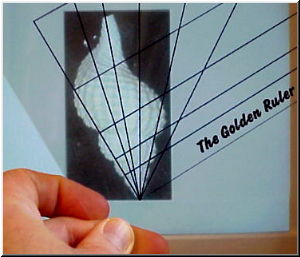
Here’s a small sample grid or click on the Free Golden Ratio “Golden Ruler” Template below for a larger, printable version.
Golden Section Gauge
Make your own golden section gauge using the template below. It will work best if you construct it from heavy cardboard stock or plastic. Drill holes and place a brad at each of the indicated points. When the gauge is adjusted the middle arm will always show the golden section or phi point between the two outer arms.
Note: The dimensions listed actually represent the distances between the rivets and the tips, not the lengths of the pieces. It’s best to think of the gauge conceptually as being made of very fine line segments connecting at golden section points. The actual length of piece AF is thus a little longer than the distance from the rivet at A to the tip at F in order to give the rivet some room to hold. The tips of the gauge should all come together when it’s closed.
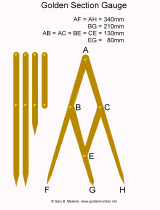
You can also download this in AutoCad format with an accompanying PDF file, courtesy of Bill Cummins.
You might find these videos helpful in making one:
https://www.youtube.com/watch?v=nBa6lpRqfE8 – cardboard construction
https://www.youtube.com/watch?v=s37RP3mVnTg- wood construction
Note that some people call this a Fibonacci gauge, but the Fibonacci series (0, 1, 1, 2, 3, 5, 8, …) is a series whose ratios converge on the golden ratio as the series increases. I think it is more appropriately called a golden mean gauge or golden ratio gauge, as that is the precise ratio that it measures.
6 sided quasi-crystal shape
You can make your own quasi-crystal shape using the template below:
Dodecahedron / Icosahedron structure
You can make your own internal structure for a dodecahedron or icosahedron, both based on phi, using the template below:
Great Pyramid of Giza Template
Here’s a template to create a pyramid with the same golden ratio proportions as the Great Pyramid of Giza.

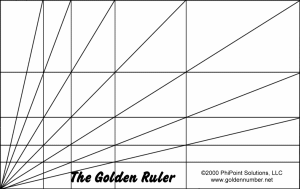
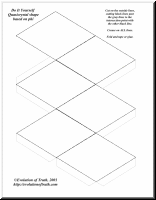
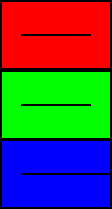
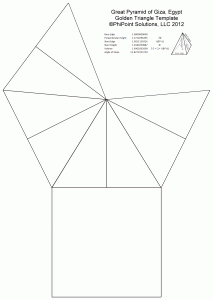

Thank you for making such sacred tools freely available.
second that
Same.
Me too
Seriously though, big up
Are there any objects at home that I can take to school to be used as an example of the golden rectangle
Best idea is to make yourself the calipers above. Then either measure random objects at home or simply take the calipers themselves to school. You’ll be amazed what you find that falls into the golden ratio.
Thankyou indeed! At last some accurate figures that I can use to make some calipers.
Thanks for the good tools 🙂
You people are great. Thank you so much for providing this information in such creative and understandable ways. Your site has been extra enjoyable at 2:45 am after working for days coding websites. I still don’t really “get it” but I will let my mind figure it out in its own time. Namaste.
Thanks a Lot for providing such a wonderful tool..I also tried to make Golden Section Gauge but failed due to the measurement issue..need to understand the length and try again..
Thanks folks very useful
regards Cookie
Thanks heaps!
I love you
damn nice homeboi
Good job very happy thank you
You are explaining to us some most amazing things in a simple way. Thank you so much
Thank you for this amazing explanation.
I have a question how to you use the Golden Ruler Grid for proportions?
Thank you so much! The person who wrote “I love you” made me laugh but it filled my heart. Therefore, I thank you a hundred times!
Wow. Thanks for hosting such a cool website with such cool content. I use phi in my design quite frequently. I will so appreciate these tools. Kindest regards.
Thanks, for help new artists for the free tool and it’s purposes. Thanks again for the extra boost.
Hope to use it for a natural means to create, and enhance an echo in musical instruments. By using the ratio, I am hoping to have less interference, by adding a mic, then might use a delay to increase the echo effect. Will let you know if it works, along with a photo or two, as well as a brief recording. Thank you for sharing this.
Good application. See other acoustic applications at https://www.goldennumber.net/acoustics/.